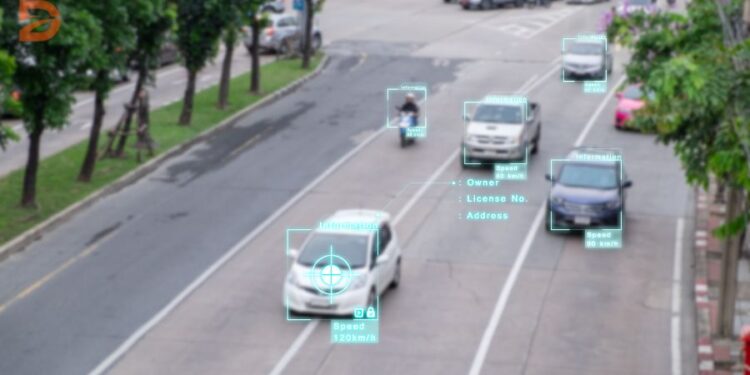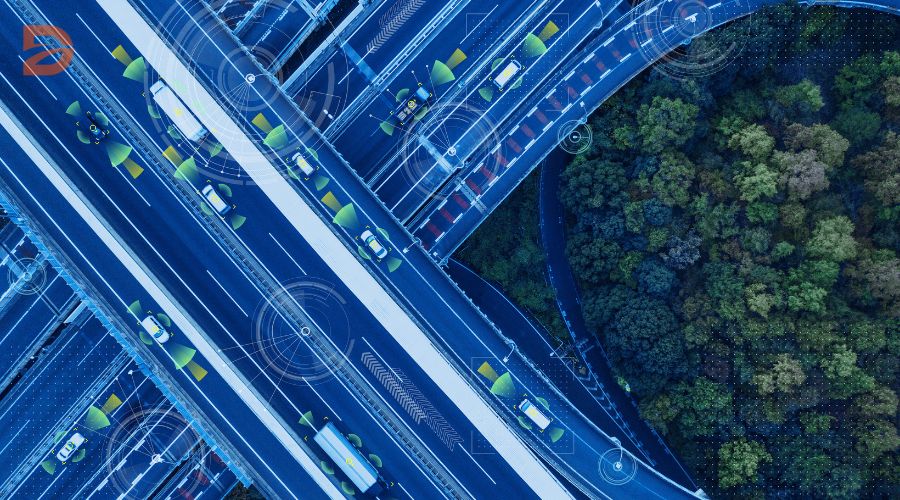In Phoenix, Arizona, the implementation of an AI-powered traffic management system has resulted in a remarkable 40% decrease in vehicle delay time. This startling statistic underscores the revolutionary impact that smart traffic systems and AI traffic management are having on urban mobility across the United States.
Sophisticated artificial intelligence (AI) algorithms are transforming the way cities manage their transportation networks, leveraging intelligent transportation systems to analyze real-time data, predict congestion patterns, and dynamically optimize traffic flows. From machine learning traffic optimization to adaptive signal control and traffic flow prediction, AI is playing a crucial role in tackling the growing challenges of traffic congestion – a problem that has significant economic, environmental, and societal consequences.
Key Takeaways
- AI-powered traffic management systems can reduce vehicle delay times by up to 40%.
- AI algorithms analyze real-time data to predict congestion patterns and dynamically optimize traffic flows.
- Advanced technologies like adaptive signal control, traffic flow prediction, and vehicle-to-everything (V2X) communication are transforming urban mobility.
- AI-based navigation apps provide real-time traffic data for dynamic rerouting, improving route efficiency.
- AI-enabled smart mobility solutions and data-driven traffic management are enhancing safety and reducing congestion levels.
The Critical Need for Traffic Flow Optimization
Traffic congestion is not merely a daily inconvenience, but a complex challenge with far-reaching consequences. The relentless growth of city populations and vehicle traffic underscores the urgent need for effective traffic flow optimization. Addressing this issue is crucial for creating a more efficient, sustainable, and livable urban environment.
Economic Impacts
Severe traffic congestion can cost cities billions annually, affecting productivity, delivery delays, and increased fuel consumption. Studies show that traffic congestion can drain the economy, leading to lost productivity, delayed deliveries, and higher fuel expenses for businesses and individuals.
Environmental Consequences
The environmental fallout of traffic congestion is equally severe. Idle vehicles contribute to poor air quality and climate change, as they emit higher levels of pollutants. Optimizing traffic flow can significantly reduce emissions and improve overall environmental sustainability.
Societal Effects
Congested roads not only reduce quality of life but also hinder emergency services and limit time for family and recreational activities. Traffic congestion can increase stress levels and restrict the time available for personal pursuits, creating social challenges for individuals and communities.
Addressing traffic flow optimization is crucial for creating a more efficient, sustainable, and livable urban environment. By leveraging technology and data-driven solutions, cities can tackle the pressing issues of traffic congestion and unlock the full potential of urban mobility.
AI’s Role in Traffic Management
Artificial Intelligence (AI) is at the forefront of transforming traffic management systems, offering innovative solutions to the age-old problem of traffic congestion. AI systems utilize machine learning and geospatial analysis to process and analyze vast amounts of traffic data from various sources, including cameras, sensors, and GPS signals. By understanding traffic patterns and predicting congestion, AI can dynamically adjust traffic signal timings and suggest alternative routes in real-time, keeping traffic flowing more smoothly.
Analyzing Traffic Data
AI-powered traffic management systems use predictive analytics to forecast traffic patterns and identify congestion points. This allows for proactive adjustments to traffic signals and recommended routes, improving overall traffic flow and reducing travel times. For example, adaptive traffic signals can decrease travel times by up to 20% through dynamic adjustments based on real-time conditions.
Optimizing Traffic Flows
Beyond just analyzing data, AI’s capabilities extend to actively managing traffic flows, enhancing the efficiency of city traffic networks, and ushering in a new era of urban mobility. AI-driven systems can integrate connected and autonomous vehicles (CAVs) to precisely control and predict the flow of vehicles and people, minimizing bottlenecks and congestion. This not only leads to smoother commutes but also contributes to sustainability goals by promoting green transportation and reducing emissions.
The integration of AI in traffic management systems offers numerous benefits, including improved travel times, reduced economic costs associated with congestion, and enhanced environmental outcomes. However, the successful implementation of these systems requires public acceptance, investment in infrastructure, and addressing challenges such as data privacy and scalability. As cities strive to optimize their transportation networks, AI-powered traffic management is poised to play a pivotal role in shaping the future of urban mobility.
Smart traffic systems, AI traffic management
The advancement of smart mobility solutions powered by artificial intelligence (AI) and intelligent transportation systems (ITS) is transforming the way cities manage their traffic networks. These cutting-edge technologies are revolutionizing the traditional traffic management approach, leading to enhanced urban mobility and a more efficient, sustainable, and livable urban environment.
At the heart of this transformation lies the integration of two critical technologies: machine learning and geospatial analysis. Machine learning algorithms can digest historical and real-time traffic data to predict future patterns and forecast potential issues, enabling proactive measures to prevent congestion. Geospatial data analysis, on the other hand, maps out the intricacies of urban traffic networks, identifying critical points that affect the overall flow and allowing for targeted optimization strategies.
The implementation of these advanced technologies in smart traffic management systems is already yielding tangible benefits. These systems can efficiently collect and analyze data from a vast array of sources, including vehicle-to-everything (V2X) communication, adaptive traffic control, and predictive analytics. This comprehensive data set enables city planners and transportation authorities to make informed decisions, implement adaptive traffic control measures, and optimize traffic flows for enhanced safety, reduced congestion, and improved travel times.
| State/City | Smart Traffic Management Initiatives |
|---|---|
| Colorado | The Colorado Department of Transportation (CDOT) utilizes a fiber-optic network and real-time data analysis to manage traffic on I-70, adjusting speed limits based on weather conditions. |
| Gwinnett County, Georgia | The Gwinnett County Department of Transportation has established a fiber-optic network to communicate with traffic signals and pan-tilt-zoom cameras at intersections, enabling comprehensive traffic monitoring and control. |
| Austin, Texas | The Austin Transportation and Public Works Department has been testing and implementing new intelligent transportation systems (ITS) technologies since 2015, leveraging data-driven insights to optimize traffic flow. |
As the future unfolds, the adoption of smart traffic management systems is expected to increase, driven by the growing demand for enhanced safety, reduced environmental impact, and improved community convenience. With the integration of cutting-edge technologies, cities can pave the way for a more intelligent, sustainable, and connected urban transportation landscape.
Impact of Optimized Traffic Flow
The implementation of AI-driven traffic flow optimization brings substantial benefits that enhance urban mobility and the quality of urban life. By employing sophisticated algorithms to analyze and manage traffic patterns, cities are witnessing a remarkable transformation in their daily commute dynamics. The most immediate effect is a significant reduction in traffic congestion, leading to smoother roads and less stop-and-go traffic.
As a direct consequence, travel times have improved considerably, allowing commuters and goods to move more swiftly across the city and increasing overall productivity. Additionally, with vehicles spending less time idling in traffic, emissions are drastically lowered, resulting in better air quality and contributing to environmental sustainability efforts. These enhancements contribute to a more efficient and sustainable urban environment, improving the overall quality of life for residents.
Reduced Congestion
AI-powered traffic management systems have demonstrated their ability to reduce traffic congestion by up to 20% in urban areas, as reported by McKinsey. These systems utilize real-time data and sophisticated algorithms to dynamically adjust traffic light timings, optimize signal coordination, and provide dynamic routing recommendations, leading to smoother traffic flow and a significant decrease in stop-and-go traffic.
Improved Travel Times
The integration of AI in transportation has led to remarkable improvements in travel times. For example, the Transport for London (TfL) case study shows that AI-optimized public transportation systems have resulted in a 10% increase in on-time performance and a 15% reduction in passenger wait times. Similarly, the Surtrac system in Pittsburgh, which utilizes AI to manage traffic lights, has reduced travel times by 25% and idle time at intersections by 40%.
Lower Pollution Levels
By reducing traffic congestion and improving travel times, AI-driven traffic management systems have a significant impact on lowering emissions and air pollution levels. With vehicles spending less time idling in traffic, the overall emissions from the transportation sector have decreased substantially. This not only benefits the environment but also improves the health and well-being of urban residents, as automobile pollution can lead to immediate physiological changes, such as heightened blood pressure and increased risk of heart attacks and strokes.
| Metric | Improvement |
|---|---|
| Travel Time Reduction | Up to 20% |
| On-time Public Transportation Performance | 10% increase |
| Passenger Wait Time Reduction | 15% decrease |
| Travel Time Reduction (Surtrac system, Pittsburgh) | 25% decrease |
| Intersection Idle Time Reduction (Surtrac system, Pittsburgh) | 40% decrease |
Conclusion
Harnessing the power of Artificial Intelligence in traffic management systems holds immense potential for transforming urban mobility and addressing the pressing challenges of traffic congestion. By leveraging machine learning, geospatial analysis, and real-time data processing, cities can optimize traffic flows, reduce congestion, improve travel times, and lower pollution levels. The successful integration of AI-driven traffic management solutions requires a strategic approach, including the assessment of current infrastructure, the selection of appropriate AI technologies, comprehensive data collection and analysis, and seamless integration with existing systems.
As cities continue to embrace these innovative AI in traffic management solutions, the future of urban transportation promises to be more efficient, sustainable, and responsive to the evolving needs of citizens. The adoption of AI in traffic management represents a significant stride towards the realization of smart city development, where the well-being and mobility of residents are prioritized. The integration of AI-powered traffic management systems holds the key to unlocking a future of enhanced urban mobility, paving the way for more livable and environmentally-conscious cities.
The successful implementation of AI in traffic management systems is a testament to the transformative potential of technology in addressing the complex challenges of urban transportation. As cities around the world continue to embrace these innovative solutions, the future of mobility holds the promise of a more efficient, sustainable, and responsive urban landscape, where the needs of citizens are at the forefront of urban planning and development.
FAQ
What is the role of AI in transforming urban traffic management?
Artificial Intelligence (AI) is revolutionizing traffic management systems by utilizing sophisticated algorithms to analyze real-time traffic data, predict congestion patterns, dynamically adjust signal timing, and optimize routes to reduce overall congestion.
What are the key technologies enabling AI-driven traffic optimization?
The advancement in AI-driven traffic optimization is largely powered by two critical technologies: Machine Learning and Geospatial Analysis. Machine learning algorithms can digest historical and real-time traffic data to predict future patterns and forecast potential issues, enabling proactive measures to prevent congestion. Geospatial data analysis maps out the intricacies of urban traffic networks, identifying critical points that affect the overall flow and allowing for targeted optimization strategies.
What are the benefits of implementing AI-driven traffic flow optimization?
The implementation of AI-driven traffic flow optimization brings substantial benefits that enhance urban mobility and the quality of urban life. These include a significant reduction in traffic congestion, improved travel times, and lower emissions, contributing to a more efficient and sustainable urban environment.
How can cities effectively integrate AI-driven traffic management solutions?
The successful integration of AI-driven traffic management solutions requires a strategic approach, including the assessment of current infrastructure, the selection of appropriate AI technologies, comprehensive data collection and analysis, and seamless integration with existing systems.
What is the future of urban mobility with the adoption of AI in traffic management?
As cities continue to embrace these innovative solutions, the future of urban transportation promises to be more efficient, sustainable, and responsive to the evolving needs of citizens. The adoption of AI in traffic management represents a significant stride towards the realization of smart, livable cities that prioritize the well-being and mobility of their residents.










